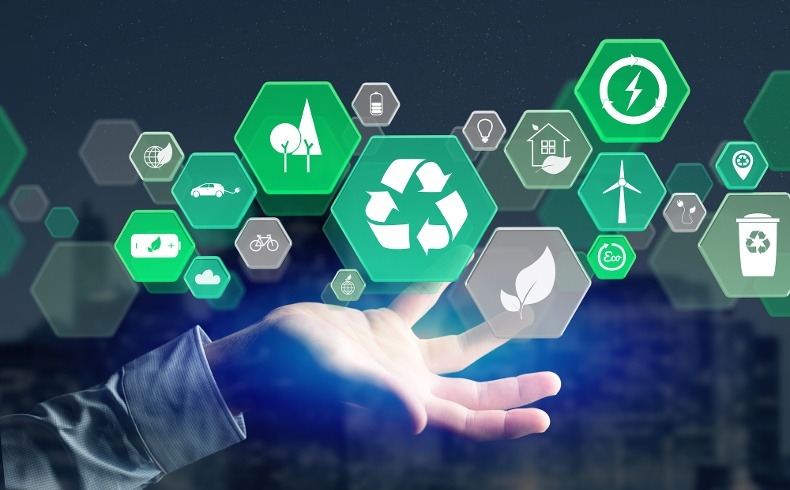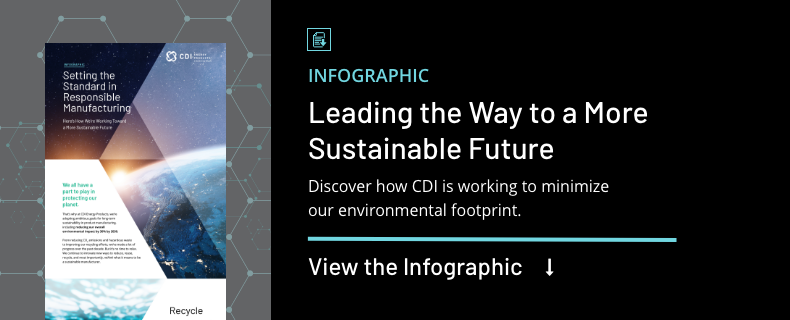
Are Thermoplastics Sustainable?
Posted by CDI Products on Sep 29, 2021
Plastic items have been developed and used extensively during the last half-century, and most of this plastic is still around today because it doesn’t biodegrade. There’s significant focus on how to make these products – which do so much to benefit people’s lives worldwide – more environmentally friendly and recyclable.
Despite the innovations made in the recycling industry over the past several decades, many plastics are not easily or effectively recycled or reused. A 2017 study in the peer-reviewed journal Science Advances indicates that only 9% of plastics are recycled.
Recycling plastic products, however, is only a portion of the solution. Typically, waste material is generated during the plastic production process and product manufacturing due to the subtractive manufacturing approach many businesses use. Often, this scrap material is deemed unusable and is discarded.
Are Thermoplastics Really Recyclable?
This is where thermoplastics are different. Thermoplastics have a unique property that boosts their potential for usage while minimizing underutilized, wasted material. Sustainable thermoplastic compounds are being used in a wide variety of consumer, commercial, and industrial products. Businesses of all sizes in industries such as energy, aviation, medical, industrial, chemical, semiconductor, and automotive are benefiting from developments in polymer science.
High-quality thermoplastic polymers enable producers to develop the durable, long-lasting, and environmentally responsible products that the world needs.
Wait a moment, are we suggesting that thermoplastics should be recycled more than they currently are? Yes, in a nutshell.
Thermoplastics are a form of plastic that become soft when heated, allowing for molding, and then return to their stiff state when cooled. They’re often used to manufacture a variety of products, including pipes, insulators, and adhesives, and a large number of these products can be recycled and repurposed. What makes thermoplastics recyclable is their ease of reheating and remolding for new applications. (For a more technical look at thermoplastic recyclability, see this peer-reviewed article.)
The thermoplastic polymers are strong but have weak intermolecular bonds. This property enables them to be reused, which contributes to their high recycling rate. Diverse uses can degrade plastics during recycling, making them less recyclable at each stage of recyclability. However, this is typically due to additives, not the polymers themselves.
It’s important to remember that chemical additives used to strengthen the intermolecular bonds of thermoplastics often make them more difficult to melt, thereby restricting their recyclability. Thermoplastics without certain additives have the characteristics challenging applications need while delivering the recyclability good environmental stewards seek.
Because thermoplastic material can be melted repeatedly, thermoplastic products are the raw material of the future. This has a big positive impact on the global plastic waste problem. In the long run, this significantly contributes to the development of a circular economy and a sustainable future.
Can thermoplastics really handle tough conditions if they can be melted down? Thermoplastics have excellent toughness, damage tolerance, energy absorption, impact resistance, corrosion resistance, and temperature performance, among other features. (See our blog on thermoplastics to learn more about their characteristics.)
How Do Thermoplastics Benefit the Global Economy?
It all comes down to energy. Thermoplastic polymer manufacturing often requires shorter production cycles than other plastic materials, which results in significant energy savings. Consider thermoplastics in comparison to another frequently used material: thermosets.
Thermosets begin as monomers that must be kept at elevated temperatures and pressures for an extended amount of time to polymerize while being restricted to their ultimate shape. In comparison, thermoplastics are heated to soften them and then shaped. As a result, the time required to process a thermoplastic composite is often less than 10 minutes, resulting in significantly lower energy consumption per part.
Thermoplastics make manufacturing easier since their manufacturing processes are easily automatable and multiple thermoplastic components may be joined or connected without the need for adhesives or fasteners.
Another demonstration of waste reduction is the manufacturing method known as extrusion, which involves melting the plastic material and feeding it through a series of tubes into a mold of the desired shape. With other materials, the raw material may become caught in the extrusion tubes, making removal and re-molding difficult. However, because thermoplastics can be heated and softened repeatedly, it’s simple to clean extrusion equipment of unused or waste plastic so they can be reused.
Another energy-saving feature of thermoplastics is that they do not require refrigeration. It’s fairly uncommon for a medium-sized thermoset production company to operate huge freezers, which need capital equipment and long-term electricity usage. Thermoplastics eliminate all of this expense because they can be stored at ambient temperature and have an extraordinarily extended shelf life.
With so many energy, time-, and cost-saving benefits, numerous industries are transitioning to thermoplastics for high-volume composite applications.
Where Can Recycled Thermoplastics Be Used?
If a design engineer is developing a new line of laser printers and deciding on the material to use for the roller gears, for example, using a recycled thermoplastic such as ABS for injection molding would provide the same application benefits — good natural lubricity, high heat resistance, and durability — but in a more resourceful manner.
It may appear to be a small step, but it moves us closer to a circular economy in which nothing is wasted, and everything is reprocessed and reused. By sourcing recycled materials, design engineers can achieve the same end result with a smaller environmental effect.
Utilization of Eco-Friendly Thermoplastics
Thermoplastic substances enable humans to live more sustainably. Due to the lightweight nature of thermoplastics, plastic requires less energy to carry, and thermoplastics in airplanes and automobiles improve fuel efficiency. Thermoplastic food packaging contributes to food waste prevention. Plastics used in construction and building can help minimize energy consumption.
It’s All About Long-Term Viability
In broad terms, sustainability refers to the maintenance of a balanced environment, such as a wholly recycled industrial facility. In general terms, it refers to a completely balanced community or planet in which waste is totally incorporated into the system in a productive manner. It entails restoring equilibrium to the community as a whole (i.e., the workforce, the neighborhood, the industry, the global market).
Is Thermoplastic Composite Material the Final Answer to a Sustainable Environment?
Unfortunately, the answer is no. Recycling will not occur unless there is sufficient motivation, which includes financial incentives and government rules, as well as a shift in society thinking.
In addition, thermoplastic composites include additives and reinforcements. This reduces the attractiveness of the recyclable materials on the open recycling market. Most buyers are looking for unfilled or unmodified polymers, making composites difficult to sell to recyclers.
Nonetheless, thermoplastics offer significant sustainability benefits over conventional plastic materials, promoting a more ethical and environmentally friendly plastic solution.
Given that plastic is unlikely to disappear anytime soon, chemists who understand the ins and outs of this pernicious substance are attempting to make it easier to recycle and convert into higher-quality material that may be used for a wider variety of purposes. Daily progress is being made, with major research and development focusing on completely sustainable, biodegradable, or bio-sourced materials that exhibit the properties and qualities of typical high-performance plastics.
Scientists are actively investigating ways to improve plastic’s recyclability and reuse. (See this article, “Chemists are reimagining recycling to keep plastics out of landfills,” to learn more about this research in action.) As the world’s attention turns to measures to reduce plastic waste and to increase the reuse and recycling of plastic materials, we appreciate the inherent sustainability properties of thermoplastics. There are significant efforts today to find ways to recycle all plastics effectively, regardless of classification, with more opportunities as technology continues to evolve.
To learn if thermoplastics will suit your next project, start a conversation with our application engineers.
Topic: engineered thermoplastics, thermoplastics, innovations in polymer science

